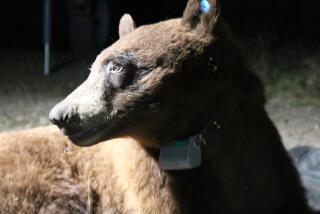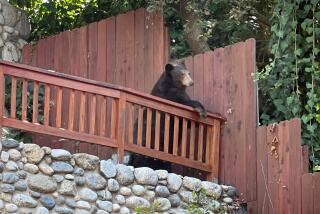Grrrrr! Angry herders secure bear ban from France’s Macron

- Share via
PARIS — The bears have cute names — Bubble, Feather, Snowflake and the like — and look so soft and huggable when caught on video by remote cameras that study their habits. But to herders high in the Pyrenees mountains of southwestern France, the animals are stone-cold killers, ravaging flocks and undermining farming livelihoods.
Pyrenean livestock farmers who raise sheep for meat and famously pungent cheeses are rejoicing after getting an assurance from President Emmanuel Macron that he won’t authorize the release into the wild of any more of the bears blamed for a surge in deadly attacks.
“He promised that the reinsertions [of bears] are finished, that he won’t release any more,” said Jean-Pierre Pommies, who raises sheep and cows. Pommies wore his broad farmer’s beret to Tuesday’s meeting with Macron, who was in a suit and tie, in Pau, a Pyrenean town with sweeping views of the mountains.
“He was able to understand that it’s a big problem for us,” Pommies added. “We have reached the bottom, and the situation was ridiculous for Pyrenean herders.”
When France’s last pocket of brown bears appeared headed for extinction in the Pyrenees in the 1990s, the country began importing animals from Slovenia, where the population is booming. A total of eight were released into the wild in 1996, 1997 and 2006. Another release of two Slovenian female bears — Claverina and Sorita — followed in 2018, the first first full year of Macron’s presidency.
The population is now estimated at 40 bears, doubling its size since 2010 and roaming over a long and expanding swath of the mountains that form the border between France and Spain, stretching from the Mediterranean to the Atlantic.
Bear attacks on livestock have grown, too. Having long been largely stable, mostly between 100 and 200 attacks a year across the Pyrenees, including Spain, France and Andorra, they surged to close to 400 in 2018, according to the most recent official annual report.
Herders who suffered included one of Pommies’ friends, whose flock was devastated in an attack last year, he said. The sheep took fright and plunged off a cliff together.
“There were 256 piled up at the bottom,” he said. “They had to finish some of them off with their knives. For us shepherds, that is traumatic.”
He believes the presence of the predators is simply “incompatible” with the Pyrenean mountain economy that rests largely on herding.
“I love bears. I’m passionate about them as animals. But I love that they live happily in Yellowstone, in Canada, in Romania and Slovenia,” he said. In the Pyrenees, “the people who are pro-bear say that it used to work for the old-timers, that they used to deal with it. And that is completely false. History shows that men have always killed them.”
The Pyrenees are only one of the battlegrounds in Europe over efforts to preserve wild fauna and flora. In France’s other major mountain range, the Alps, wild wolves that also prey on flocks are a persistent source of tension between herders and those opposed to the deployment of large dogs to keep wolf packs at bay.
In Germany, wolves have been a source of political friction. The far-right opposition Alternative for Germany party accused the government of failing to defend farmers’ interests against the 75 wolf packs counted there in 2018. There is also debate in Belgium about the reappearance of wolves after infrared cameras spotted a pair together in woods and a pregnant wolf was killed in northern Belgium last summer.
Slovenia’s brown bear population is so plentiful that authorities are culling the animals that are becoming a headache for farmers, raiding beehives and even attacking people in the small Alpine state. About 170 bears were shot in 2019, said Damjan Orazem, the Forest Service director.
Herders including Pommies pounced on Macron to talk about the Pyrenees’ bears when the French leader turned up at the Tour de France last year on a day when the bicycle race swung through the peaks. Pommies said he threatened to release his animals into the riders’ path unless Macron agreed to a meeting. That brief encounter elicited a pledge from Macron that he’d hold talks with them at length at a later date, an offer he made good on this week.
Emmanuelle Wargon, a deputy environment minister who attended the meeting, told broadcaster Sud Radio that Macron “reaffirmed that we don’t have any plans to reintroduce [more] bears,” adding: “It was important to tell them this.”
For bear preservationists, herders are greatly exaggerating the risk posed by the predators. Alain Reynes, director of the group Country of the Bear, said he believes the actual number of animals killed by bears is far smaller than the 1,500, mostly sheep, that Pyrenean herders claim they lost last year.
Reynes also said that Macron’s moratorium on bear releases can’t last, because France is obliged by European law to ensure that the bear population remains viable.
“The president can only speak for the period of his mandate,” he said. “There have always been bears. The history in the Pyrenees is one of cohabitation, even if it hasn’t always been easy.... There have been bears in Europe for 250,000 years. This is their space.”
___
Associated Press writers Raf Casert in Strasbourg, France; Dusan Stojanovic in Belgrade, Serbia, and Mike Corder in The Hague contributed to this report.
More to Read
Sign up for Essential California
The most important California stories and recommendations in your inbox every morning.
You may occasionally receive promotional content from the Los Angeles Times.










